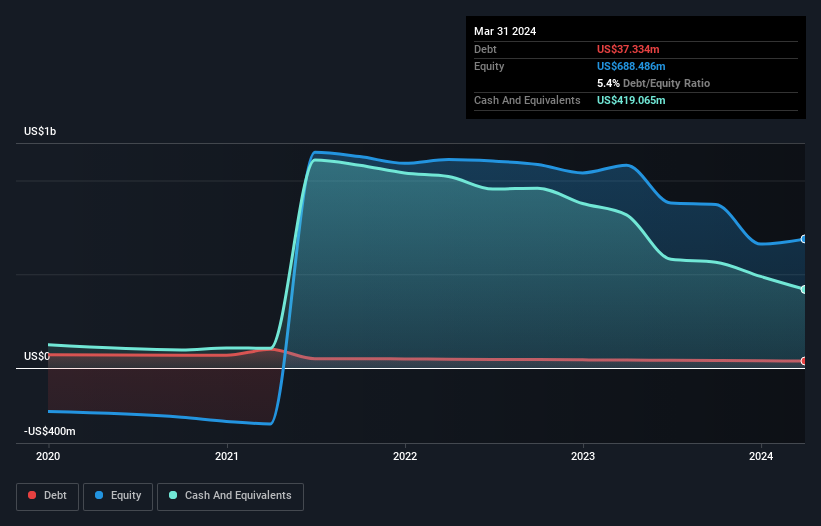- United States
- /
- Healthcare Services
- /
- NYSE:AGL
Rock star Growth Puts agilon health (NYSE:AGL) In A Position To Use Debt

Some say volatility, rather than debt, is the best way to think about risk as an investor, but Warren Buffett famously said that 'Volatility is far from synonymous with risk.' So it might be obvious that you need to consider debt, when you think about how risky any given stock is, because too much debt can sink a company. We can see that agilon health, inc. (NYSE:AGL) does use debt in its business. But is this debt a concern to shareholders?
What Risk Does Debt Bring?
Debt and other liabilities become risky for a business when it cannot easily fulfill those obligations, either with free cash flow or by raising capital at an attractive price. Ultimately, if the company can't fulfill its legal obligations to repay debt, shareholders could walk away with nothing. While that is not too common, we often do see indebted companies permanently diluting shareholders because lenders force them to raise capital at a distressed price. Of course, the upside of debt is that it often represents cheap capital, especially when it replaces dilution in a company with the ability to reinvest at high rates of return. When we examine debt levels, we first consider both cash and debt levels, together.
See our latest analysis for agilon health
What Is agilon health's Net Debt?
As you can see below, agilon health had US$37.3m of debt at March 2024, down from US$42.2m a year prior. However, it does have US$419.1m in cash offsetting this, leading to net cash of US$381.7m.

How Strong Is agilon health's Balance Sheet?
We can see from the most recent balance sheet that agilon health had liabilities of US$1.53b falling due within a year, and liabilities of US$101.3m due beyond that. Offsetting this, it had US$419.1m in cash and US$1.57b in receivables that were due within 12 months. So it actually has US$362.2m more liquid assets than total liabilities.
This short term liquidity is a sign that agilon health could probably pay off its debt with ease, as its balance sheet is far from stretched. Succinctly put, agilon health boasts net cash, so it's fair to say it does not have a heavy debt load! When analysing debt levels, the balance sheet is the obvious place to start. But it is future earnings, more than anything, that will determine agilon health's ability to maintain a healthy balance sheet going forward. So if you want to see what the professionals think, you might find this free report on analyst profit forecasts to be interesting.
Over 12 months, agilon health reported revenue of US$4.9b, which is a gain of 74%, although it did not report any earnings before interest and tax. Shareholders probably have their fingers crossed that it can grow its way to profits.
So How Risky Is agilon health?
By their very nature companies that are losing money are more risky than those with a long history of profitability. And we do note that agilon health had an earnings before interest and tax (EBIT) loss, over the last year. And over the same period it saw negative free cash outflow of US$185m and booked a US$202m accounting loss. But at least it has US$381.7m on the balance sheet to spend on growth, near-term. With very solid revenue growth in the last year, agilon health may be on a path to profitability. By investing before those profits, shareholders take on more risk in the hope of bigger rewards. There's no doubt that we learn most about debt from the balance sheet. However, not all investment risk resides within the balance sheet - far from it. Be aware that agilon health is showing 2 warning signs in our investment analysis , you should know about...
If you're interested in investing in businesses that can grow profits without the burden of debt, then check out this free list of growing businesses that have net cash on the balance sheet.
New: AI Stock Screener & Alerts
Our new AI Stock Screener scans the market every day to uncover opportunities.
• Dividend Powerhouses (3%+ Yield)
• Undervalued Small Caps with Insider Buying
• High growth Tech and AI Companies
Or build your own from over 50 metrics.
Have feedback on this article? Concerned about the content? Get in touch with us directly. Alternatively, email editorial-team (at) simplywallst.com.
This article by Simply Wall St is general in nature. We provide commentary based on historical data and analyst forecasts only using an unbiased methodology and our articles are not intended to be financial advice. It does not constitute a recommendation to buy or sell any stock, and does not take account of your objectives, or your financial situation. We aim to bring you long-term focused analysis driven by fundamental data. Note that our analysis may not factor in the latest price-sensitive company announcements or qualitative material. Simply Wall St has no position in any stocks mentioned.
Have feedback on this article? Concerned about the content? Get in touch with us directly. Alternatively, email editorial-team@simplywallst.com
About NYSE:AGL
agilon health
Provides healthcare services for seniors through primary care physicians in the communities of the United States.
Undervalued with adequate balance sheet.

